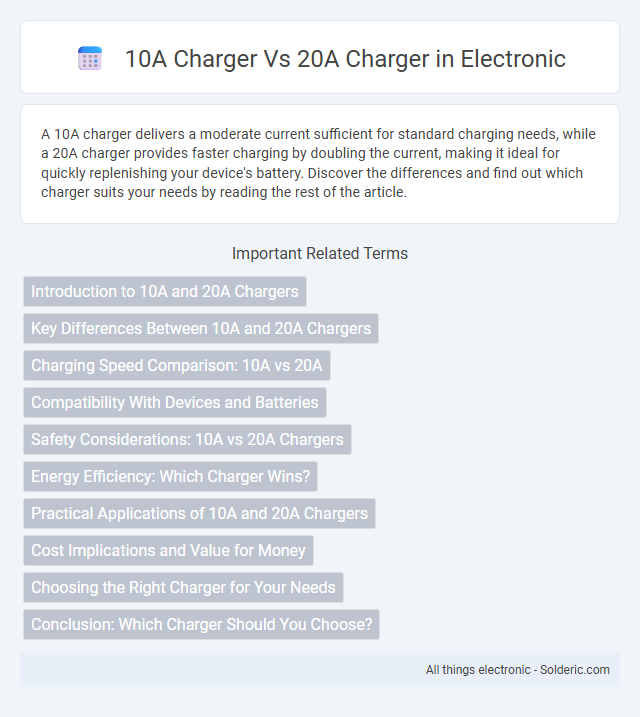A 10A charger delivers a moderate current sufficient for standard charging needs, while a 20A charger provides faster charging by doubling the current, making it ideal for quickly replenishing your device's battery. Discover the differences and find out which charger suits your needs by reading the rest of the article.
Comparison Table
| Feature | 10A Charger | 20A Charger |
|---|---|---|
| Current Output | 10 Amperes | 20 Amperes |
| Charging Speed | Standard speed, slower charging | Faster charging, doubles speed |
| Power Consumption | Lower power usage | Higher power usage |
| Device Compatibility | Compatible with most low-amp devices | Best for high-current devices |
| Cost | Generally more affordable | Higher cost due to increased capacity |
| Heat Generation | Less heat produced | More heat, requires better cooling |
| Usage Scenario | Ideal for everyday slow charging | Suitable for fast charging needs |
Introduction to 10A and 20A Chargers
10A chargers deliver a maximum current of 10 amperes, making them suitable for smaller devices or slower charging needs, while 20A chargers provide double the current at 20 amperes, enabling faster charging for larger batteries or high-power electronics. Your choice between a 10A and 20A charger impacts charging speed, device compatibility, and overall efficiency, with 20A chargers often preferred for modern smartphones, tablets, and laptops. Understanding the amperage difference helps optimize your charging setup for safety and performance.
Key Differences Between 10A and 20A Chargers
10A chargers deliver a maximum current of 10 amperes, suitable for charging devices at a moderate speed, while 20A chargers provide twice the current, enabling faster charging for compatible devices. The higher amperage in 20A chargers results in reduced charging time and improved efficiency, particularly for larger batteries or high-power electronics. Device compatibility, cable quality, and safety standards vary between the two, with 20A chargers often requiring thicker cables and enhanced protection mechanisms to handle increased electrical load safely.
Charging Speed Comparison: 10A vs 20A
A 20A charger delivers twice the current of a 10A charger, significantly reducing charging time for compatible devices. The 20A charger provides faster energy transfer, enabling up to 50% quicker charge cycles compared to the 10A model. This increased amperage is ideal for high-capacity batteries, enhancing overall charging efficiency and performance.
Compatibility With Devices and Batteries
A 10A charger typically supports lower power output suitable for small to medium-capacity batteries and devices like smartphones and tablets, ensuring safe and efficient charging without overheating risks. A 20A charger delivers higher current, compatible with larger batteries such as those in laptops, power tools, and some EV chargers, enabling faster charging times but requiring devices designed to handle greater amperage. Using a charger with an amperage higher than the device's rating may cause compatibility issues or damage, so selecting a charger matched to the battery's specifications is crucial for optimal performance and safety.
Safety Considerations: 10A vs 20A Chargers
A 10A charger typically offers lower current output, reducing the risk of overheating and electrical faults, making it safer for devices with limited power tolerance. In contrast, a 20A charger delivers higher current, which can expedite charging but requires compatible wiring, proper circuit breakers, and quality components to prevent potential hazards such as short circuits or thermal damage. Ensuring charger specifications align with device requirements and adherence to safety certifications like UL or CE is crucial for both 10A and 20A chargers to maintain safe operation.
Energy Efficiency: Which Charger Wins?
A 20A charger generally operates more efficiently than a 10A charger because it delivers higher current, reducing overall charging time and minimizing energy loss during power transfer. Both charger types convert AC to DC power, but a 20A charger's ability to supply more amperage means less energy waste and improved performance, especially for devices or batteries that support fast charging. Your choice affects charging speed and energy consumption, with the 20A charger typically offering better energy efficiency for compatible electronics.
Practical Applications of 10A and 20A Chargers
10A chargers are ideal for smaller devices like smartphones and tablets, offering efficient charging without overheating. 20A chargers provide faster charging speeds, suitable for larger devices such as laptops or power-hungry electronics. Your choice between a 10A and 20A charger depends on the power requirements and charging time you prioritize.
Cost Implications and Value for Money
A 10A charger generally costs less upfront and consumes less electricity, making it a budget-friendly choice for users with moderate charging needs and lower power bills. In contrast, a 20A charger offers faster charging speeds that can improve convenience and reduce downtime, justifying its higher price for those prioritizing time efficiency and frequent use. Evaluating the balance between initial investment, energy consumption, and charging speed is essential to determine the best value for money based on individual usage patterns.
Choosing the Right Charger for Your Needs
Choosing the right charger between a 10A and 20A charger depends on your device's power requirements and charging speed preferences. A 10A charger delivers up to 120 watts, suitable for smartphones and smaller gadgets, while a 20A charger provides up to 240 watts, ideal for tablets, laptops, or fast charging needs. Assess your device specifications and charging habits to ensure your charger matches your power consumption for optimal efficiency.
Conclusion: Which Charger Should You Choose?
A 20A charger delivers faster charging speeds for compatible devices, reducing overall charge time compared to a 10A charger, which is suitable for lower power needs and smaller batteries. Choosing a charger depends on your device's maximum charging capability and your priority for convenience versus energy consumption. For optimal performance and future-proofing, a 20A charger is generally preferable if your devices support higher current input.
10A charger vs 20A charger Infographic

 solderic.com
solderic.com